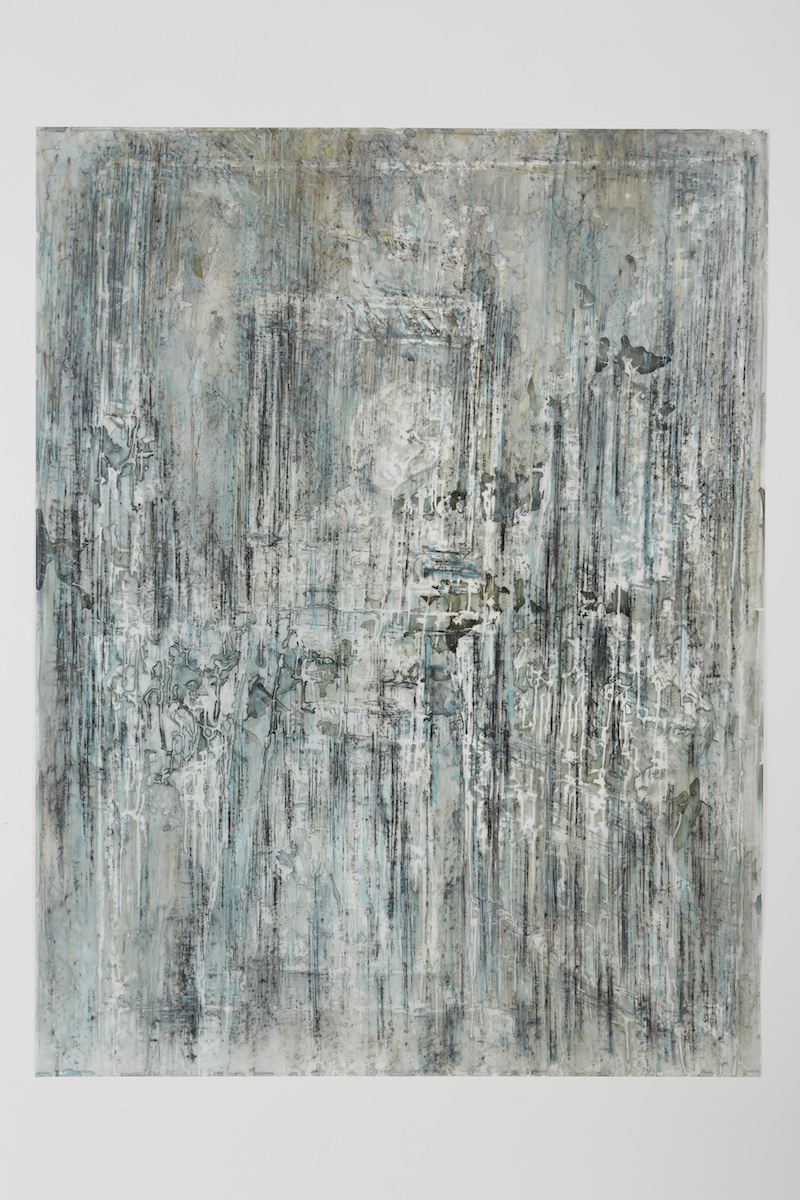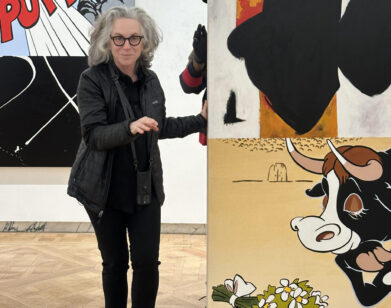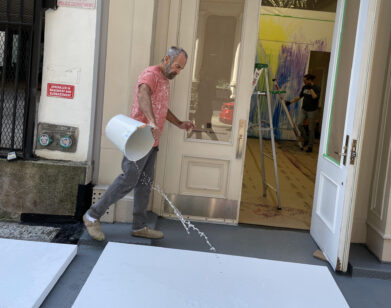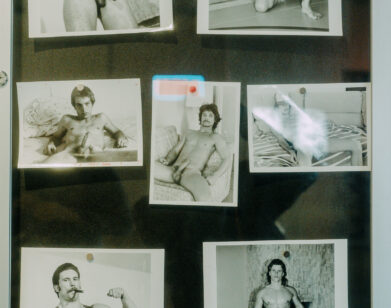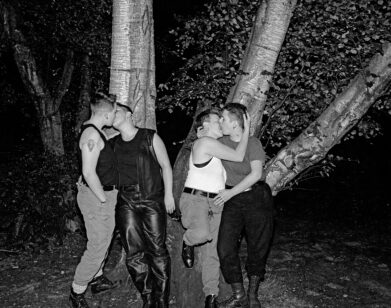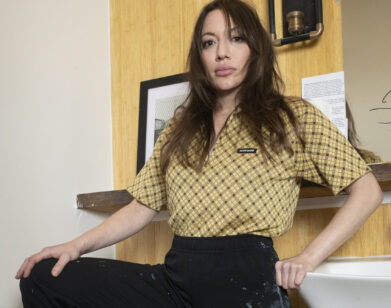Diana Al-Hadid’s Babylon
Moments after arriving at artist Diana Al-Hadid’s Bushwick studio, we witnessed a small victory: a house, a miniature version of the artist’s own in Ohio, begins to float. Her assistant had managed to balance it on a steel strand. It hovered as a roughly three-foot extension of a ceiling-height sculpture, springing from a disembodied cloak and human head. Like most of her pieces, the work wavers between figurative and hazily architectural; viewers glimpse realistic detail amid sinuous abstract lines traced in the air, as if suspended by magic.
Yet Al-Hadid was wryly pragmatic as she demonstrated how different parts of the swooping construction slip apart, then together again. She vigorously shook it—which is, we’ll attest, terrifying for an unwitting bystander—to prove its soundness. Now 32, she’s been playing with these materials—polymer gypsum, fiberglass, gold leaf and more—her whole adult life. She is understandably blasé when while we marvel at the networks of dripping ribbons, cloth folds, wispy framework, and blank head, comprising the centerpiece of her latest show at Marianne Boesky Gallery.
Today, her style is peerless, but this exhibition pairs her with the 19th century sculptor Medardo Rosso. Similar to Al-Hadid, Rosso finished his three-dimensional bronzes with a painterly touch. At Marianne Boesky, a bust of a boy, El Locch (1881-1882) will be on display. El Locch, which means “The Hooligan,” echoes the head in the main sculpture, while the figure’s shirt and hair pick up the wavy, chaotic texture of of Al-Hadid’s surfaces.
The painting-sculpture blend is further highlighted in rough, watery “panels” to be included in the show. These Al-Hadid painted on wet plaster, letting dripping colors find their own way. Larger-than-life vanity mirrors are also equally a product of chance and the artist’s “controlling” tendencies: a gold one “melts reflective juices” into a precise motif (and she admits to adding a single droplet to look like a splash). Another, in bronze, preserves the cracks from when Al-Hadid threw its wax cast on the floor. Meticulous as she is, Al-Hadid delights in the unexpected characteristics of her materials, even as she wants to master them.
Born in Aleppo, Syria and raised in Ohio, Al-Hadid started studying art history and drawing at Kent State University, though soon traded her sketchpad for more versatile elements, concocting experiments with materials, just to see what would happen. Eventually getting her MFA at Virginia Commonwealth University, she’s had works featured in a number of international shows, including a solo show at Los Angeles’s Hammer Museum. Now based in Brooklyn, she will have another solo show at Vienna’s Secession Museum this September.
We met Al-Hadid on a Sunday. She kept thinking of things to say about pieces in her studio, some still in progress, and joked that she was “babbling on.” This turned out to be the name of a nearby canvas—Bablyon—and we decided it’s a fitting word to address her manifold show.
DIANA AL-HADID: I have a harder time talking about my most recent work. I think that’s probably typical with everyone. So, that, [pointing towards the central sculpture], that’s probably the biggest piece in the show. It’s going to be in the top space where there’s a skylight. The skylight will [have the visual effect of] decapitating the head. I was making this tall thing and I was like, “Oh, I wonder what that would be like if, you know, the head was up in the clouds.” [laughs] There’s this drawn face that’s like a mask [superimposed over the head].
SMALL: Like the dividing lines when you’re drawing a face.
AL-HADID: I’m making these like pooling plaster surfaces that are very clearly made in one direction. Like spilled, made horizontally, on a plane. But they they are reinforced and can be used as a little gravity trick. I kind of pooled it and then reinforced it, and then I used it as sort of a way to make the surface of the pedestal look really slippery and in motion. In other works, there are these really hard geometries that anchor the work or act as a skeletal support. But then, everything is a little bit flexible. It’s not literally flexible but it looks like it’s moving. There’s something about liquidity that’s really important to me. I start out with all the materials being liquid. But [in the final product] everything is rigid.
SMALL: That’s how it gets such an interesting, unique shape.
AL-HADID: It’s about finding the edges of something very carefully and slowly. Mapping it out. The materials have a different internal logic or some different story. I like the recklessness of chance. It’s nice to start with some mess and then cultivate it into something more. Everyone seeks order in chaos. It is something that I tend to balance a lot in my work.
SMALL: I feel like, in your work, there’s this dichotomy between an architectural structure and these details, which are more organic. Drips, this liquid aesthetic. These heads. Architecture is more static. I feel like your work combines the two. It might have an architectural foundation, but then these organic details make it breathe.
AL-HADID: I mean especially as far as I plan or don’t plan, like that relationship of sketching something out in broad strokes and leaving some areas a little fuzzy, just to discover. I feel like that’s true. I’ve noticed how much of it is a random gut thing. It’s also following the lead of the materials and knowing how to interpret them over and over. I see if they’ll behave a different way, and I’ll try to exploit that. My materials themselves don’t vary; I have like a standard set of materials that I work with, but there’s some flexibility between. With each of those materials, I kind of rethink each project. I’ve never done a drawing like that with the cloak before [on the main sculpture], so this is kind of like the first one. Or the sketch of the face. But that, for example, was after I made the cloak, and totally a gut thing. I was staring at the head and thought it needed a face. It’s kind of backwards. It’s like drawing after the thing is made. It’s doing it in reverse. These processes, that’s how it all grows.
SMALL: I’ve been reading about your sculptures, and how they’ve been compared to ruins. You were born in Aleppo, which is a city that is layered with ruins, both from present conflicts and from past civilizations, some thousands of years old. Has that influenced your work?
AL-HADID: Definitely, in some ways. It’s interesting to find out how often civilizations have been stacked on top of each other. If you look at history at a close range the boundaries are so distinct, but when you pull back you realize that in Aleppo, there are all kinds of Hellenistic ruins everywhere and different civilizations have left a footprint. It is interesting and it’s a tricky thing to consciously incorporate into your work. I have a tendency to build in a spontaneous way. Messy and rough around the edges. I have the sense that it’s partly in my personality to make work that looks ruined. It feels like it comes more out of my personality or out of my process than it comes out of a conceptual framework, or kind of a commentary about the psychology of ruins–which is fascinating.
SMALL: There’s definitely an issue with art historians right now: this issue of preserving millennia-old ruins, but in the face of current issues that are completely removecd.
AL-HADID: It’s funny how much of an effort we make as a civilization to restore history. We [Al-Hadid and husband John Lott] went to Turkey. [In the town of Ephesus], there were fragments of frescos. Literally hundreds of miscellaneous fragments. It’s crazy when you think about going to all this effort to restore this fresco from this one district from a town in Istanbul. Then in one moment, we wipe out an entire population in Syria. That kind of stuff really resonates. I feel like that fantasy to restore the past is so deeply engrained in us and it’s also irrational and it’s impossible. There’s only so far we can go, unless we figure out space travel. There’s something that’s always lost. You kind of have to, at some point, accept it. That’s depressing. [laughs]
SMALL: At Marianne Boesky, your work will be shown alongside a work by the 19th-century Italian sculpture by Medardo Rosso, El Locch.
AL-HADID: I learned about him when I had a show at the Nasher Sculpture Center in Dallas. They had his heads by the elevators. They were just so incredible. They were these tiny, beautiful… they had this incredible expression and this real delicacy in the materials. Maybe that’s the first thing that engaged me. At the time I was making figurative work but I had never included any heads.
[walking back to the studio, near the main sculpture]
SMALL: I know this is like day-in-day-out for you, but I’m almost nervous because this seems so fragile. I’m scared to get near it.
AL-HADID: [laughs] That’s awesome. I love that! That’s the reaction I want: “I’m afraid to get near it.”
SMALL: Or me falling on top of it.
AL-HADID: Yeah, that would hurt. I would be concerned for you and not the sculpture.
SMALL: I wanted to ask you about the scale of all of your works, too. Does your technique of experimenting with materials like this lead your working on this scale, or vice versa?
AL-HADID: I think that I’ve been just making large works for a while. I have always also done small works too… or human-scale. I will always love making big things and making entire systems. But I think it’s nice to change scale. I think I dedicated this show to having more than one project cooking at once. Whatever is going in a good way in the studio, I’ll kind of follow that. And if it’s done then it’ll go to the show.
SMALL: What do you mean by “systems”?
AL-HADID: It’s like a universe that is more environmental. It’s a world. Just think of it like a place with characters and events. I said system because I think of it as a total; there’s the structure, there’s the story. There are many things that have to hang together, so it creates a system.
SMALL: Do most of these start as drawings?
AL-HADID: No, not at all. They mostly start as pedestals. Just a box. Like a blank piece of paper.
SMALL: What were your early experiments like?
AL-HADID: They were similar. They were funny. One of them I did in undergrad really relates to this double-effect of a material. This one piece I made consisted of these balloons that I cast. I carved a balloon and then I made a mold and then I cast it in wax. I cast it hollow. I left it in my car and it was hot out. The heat in the car caused the balloon, just the wax cast, to melt. It was hollow so it looked like it had deflated. The object and the material kind of fit hand in glove.
SMALL: Did you initially make these connections between materials, or was that something that came later?
AL-HADID: That was the thing that was the most fun for me when I started making sculptures. It was this endless wealth of materials. It’s like a little science lab, figuring out what works with what. I think there was this urgency to see the inside and outside all at once, or to imagine the interior. There are certain things that remain: I still like transparency, I work with thin layers and I work with planes and drips and puddles.
SMALL: When did figurative elements, like heads and houses, become integrated become with elements like architecture and more abstract designs?
AL-HADID: I think it was spring of 2009. I started this piece called Actor. I had always steered away from figuration, because it always seemed cheesy. But I kind of forced myself to consider the human form. I was looking at a sculpture that was just a printout of a carved marble sculpture. I traced it, I kind of drew the body with these little metal rods, just like welding, extruding the form of the cloth, kind of treating it like a landscape, like an architectural form. It was just very planar. I just decided to. There wasn’t any like big revelation. I feel weird using figuration even though everything I make sort of relates to the body, or was initiated by some plan set up by my body. I had made a piece where I danced and the footprints became the blueprints of the sculpture. There’s always this implicit figure.
SMALL: What do you hope people notice about your works?
AL-HADID: A lot of the reason I’m doing this is because I don’t know, and if I don’t know I can’t expect anyone to have a specific reaction. I think that’s why it goes out there, so you can hear what people think. I’ve thought about it for a long time. It’s not just, “I hope they like it.” It’s all for selfish reasons. [laughs]
“DIANA AL-HADID: REGARDING MEDARDO ROSSO” WILL BE ON VIEW AT MARIANNE BOESKY GALLERY FROM FEBRUARY 8 TO MARCH 19.

